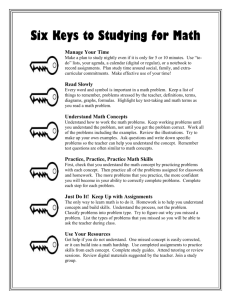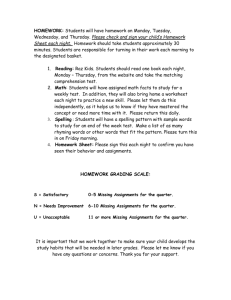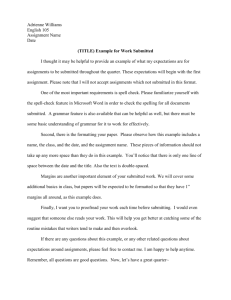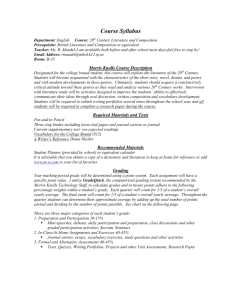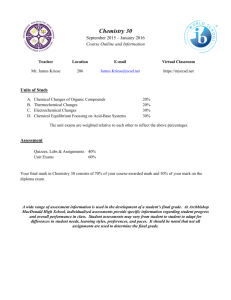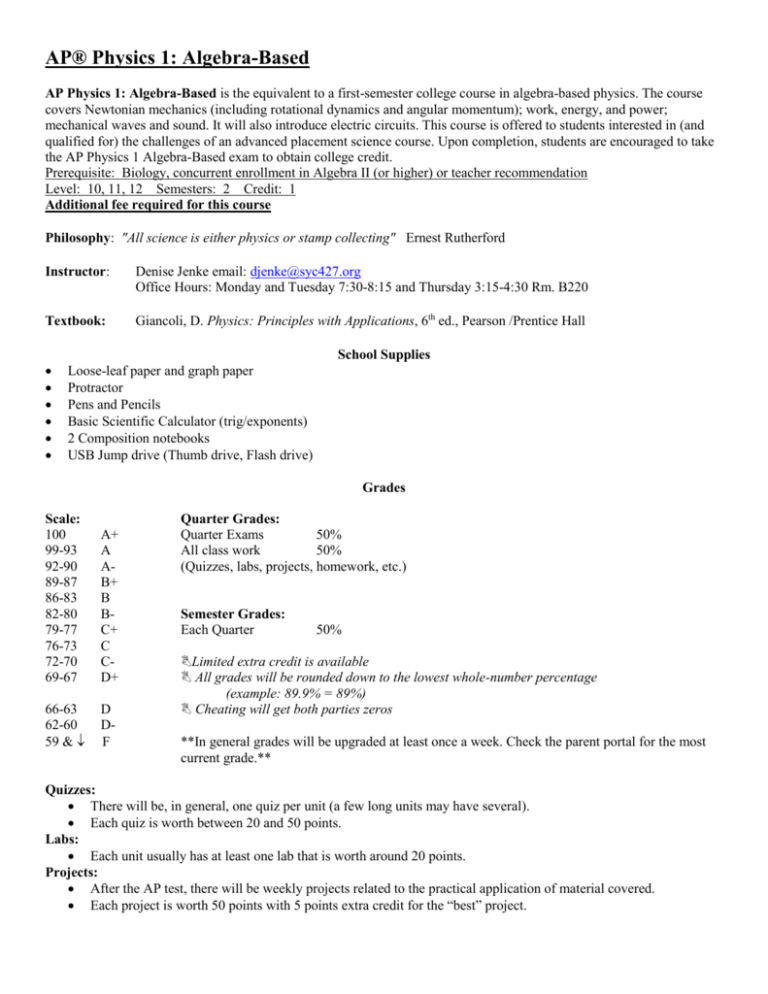
AP® Physics 1: Algebra-Based
AP Physics 1: Algebra-Based is the equivalent to a first-semester college course in algebra-based physics. The course
covers Newtonian mechanics (including rotational dynamics and angular momentum); work, energy, and power;
mechanical waves and sound. It will also introduce electric circuits. This course is offered to students interested in (and
qualified for) the challenges of an advanced placement science course. Upon completion, students are encouraged to take
the AP Physics 1 Algebra-Based exam to obtain college credit.
Prerequisite: Biology, concurrent enrollment in Algebra II (or higher) or teacher recommendation
Level: 10, 11, 12 Semesters: 2 Credit: 1
Additional fee required for this course
Philosophy: "All science is either physics or stamp collecting" Ernest Rutherford
Instructor:
Denise Jenke email: djenke@syc427.org
Office Hours: Monday and Tuesday 7:30-8:15 and Thursday 3:15-4:30 Rm. B220
Textbook:
Giancoli, D. Physics: Principles with Applications, 6th ed., Pearson /Prentice Hall
School Supplies
Loose-leaf paper and graph paper
Protractor
Pens and Pencils
Basic Scientific Calculator (trig/exponents)
2 Composition notebooks
USB Jump drive (Thumb drive, Flash drive)
Grades
Scale:
100
99-93
92-90
89-87
86-83
82-80
79-77
76-73
72-70
69-67
A+
A
AB+
B
BC+
C
CD+
66-63
62-60
59 &
D
DF
Quarter Grades:
Quarter Exams
50%
All class work
50%
(Quizzes, labs, projects, homework, etc.)
Semester Grades:
Each Quarter
50%
Limited extra credit is available
All grades will be rounded down to the lowest whole-number percentage
(example: 89.9% = 89%)
Cheating will get both parties zeros
**In general grades will be upgraded at least once a week. Check the parent portal for the most
current grade.**
Quizzes:
There will be, in general, one quiz per unit (a few long units may have several).
Each quiz is worth between 20 and 50 points.
Labs:
Each unit usually has at least one lab that is worth around 20 points.
Projects:
After the AP test, there will be weekly projects related to the practical application of material covered.
Each project is worth 50 points with 5 points extra credit for the “best” project.
Homework:
As we begin each section, you are expected to read the corresponding material in your text. Open note
reading/homework quizzes will be periodically administered. Current assignments for reading and homework
will be posted. In general the assignments for each week will be posted Monday of that week.
Homework will be not graded but the answers will be posted so that students can check their answers (they are
also available online).
Exams:
There is one exam per quarter consisting of the material covered in that quarter.
Each exam has two parts: Physics Concepts and Physics Problems.
Each part is worth 25% of the grade for that quarter (total exam grade counts for 50% of quarter grade).
Class Rules:
NO CELL PHONES ARE TO BE VISIBLE DURING THE ENTIRE 50 MINUTE CLASS PERIOD!
If I see your cell phone at anytime during class, I will confiscate it and it can be picked up at the end of
the school day.
Repeated breaking of this rule will lead to parent/administration notification
Tardies are counted and can lead to disciplinary actions.
There is no late work accepted or retakes on test or quizzes.
o Come to class prepared.
o As we begin each section, you are expected to read the corresponding material in your text prior to class.
Current assignments for reading and homework will be posted on the SHS Physics Website:
(http://jphysics.weebly.com). In general the assignments for each week will be posted Monday of that
week.
o Homework will be graded according to its accuracy and completeness. In homework that involves
writing, use complete sentences. In homework that involves calculations, show all work and circle
answers for full credit.
o Assignments that are illegible or problems that I can’t find the answers to will not be graded.
Missed class work will be handled as follows:
o Work missed due to an excused absence (illness):
NO assignments will be accepted for credit after graded assignments have been handed back (and
I am a very quick grader).
All work not made up in the appropriate time interval will revert to a zero.
It is your responsibility to make up missed work. All previous assignments, labs, and exams for
the entire year are posted in class and on SHS Physics Website. Ask a classmate what was
collected and assigned while you were gone. I will not chase after you for your work.
Homework
In general you will get one extra day to complete an assignment for each day you miss.
Tests or Quizzes
Missed exams are known about several days in advance and will be taken the day you
return to class.
Lab Activities
Labs must be made-up on a lab make-up day within a week of your return to class (with
teacher approval)
o Work missed due to a field trip, early sports dismissal, college visit, extra-curricular activity, AP
Testing, etc.
Any work that will be missed due to prearranged situations must be completed and turned in
before you miss my class. These types of absences are known about many days in advance so it
is up to you to attend to your scholastic responsibilities before the absences occur. All work
completed after such an absence will not count for credit.
o Sometimes it is not possible to make up work missed due to an absence (class discussion, class
participation, etc.). In such cases a reduced grade may be awarded even though the student is responsible
for the completion of the assignment.
Immature and disruptive behavior will not be tolerated. Failure to act in a mature and responsible manner will result
in removal from class, parental notification, Detention and/or referral to the Dean
Behavior in the lab is of the utmost importance. Failure to behavior properly will result in a zero for the lab. Repeat
misbehavior will result in expulsion from all lab activities for the semester.
(Tentative) Course Schedule for AP Physics 1:
Unit Content
1. Kinematics (including vectors, vector algebra, components of
vectors, coordinate systems. Displacement. Velocity and
acceleration)
a. Motion in one dimension
b. Motion in two dimensions, including projectile motion
2. Dynamics: Newton’s Laws of Motion
a. Static equilibrium (1st law)
b. Dynamics of a single particle (2nd law)
c. Systems of two or more objects (3rd law)
3. Circular Motion and Universal Gravitation
4. Work, Energy, and Conservation of Energy
a. Work and work-energy theorem
b. Forces and potential energy
c. Conservation of energy
d. Power
5. Impulse, Momentum and Conservation of Linear Momentum
a. Impulse and momentum
b. Conservation of linear momentum, collisions
6. Simple Harmonic Motion
7. Rotational Motion and Conservation of Angular Momentum
a. Circular motion
b. Torque and rotational statics
8. Electrostatics
a. Charge and Coulomb’s law
b. Electric field and electric potential (including point
charges)
9. Introduction to DC Circuits
a. Current, resistance, power
b. Steady-state direct current circuits with batteries and
resistors only
10. Mechanical Waves and Sound motion
11. Physics Projects
Estimated Time
4 weeks
4 weeks
2 weeks
4 weeks
3 weeks
2 weeks
4 weeks
1 week
3 weeks
2 weeks
Remaining weeks
Laboratory Investigations
Students will spend a minimum of 25% of instructional time conducting laboratory activities. Most of these activities
will be inquiry-based, where students are provided an open-ended question and a set of materials to use to investigate the
problem. In this way students will participate in activities that guide them in acquiring higher-level thinking skills such
as hypothesis development, critical thinking, experimental design, data analysis, error analysis, reaching and justifying
a conclusion, and redesigning an experiment based on results. Students will be required to record all their observations,
data, data analysis and conclusions in a laboratory journal.
Problem-Solving Strategy
To be success in AP Physics 1, students will need to learn, practice and apply an explicit problem-solving strategy that
involves five major steps:
1. Provide a physical representation (sketch and/or free-body diagram or graph) that pertains to the situation.
2. Identify the given quantities (knowns) and the unknowns.
3. Identify the physics principle(s) that pertain to the situation and write it down using an acronym (such as NLUG
for Newton’s Law of Universal Gravitation).
4. Write the mathematical representations and/or equations needed and use them to solve the problem.
5. Evaluate your answer and assess whether it is reasonable (through estimation of the answer or order of
magnitude, unit analysis, etc.).
Graphing
Many AP Physics 1 instructional activities and assessments involve graphing skills. Students will produce graphs that
are properly labeled and scaled and interpret the graphs (derivation of relationships among variables, analysis of slope,
area under the curve, intercepts and linearization of functions). The software program DataStudio® (a product of
Pasco®) will be utilized in graphing activities.
Homework Assignments
Homework assignments will serve to provide students with practice and feedback concerning both qualitatively and
quantitatively based concepts and skills. Problems from Physics (Giancoli), Physlet-based exercises, Concept
Development Exercises (from Conceptual Physics (Hewlett), material from The Physics Classroom
(http://www.physicsclassroom.com) and interactive simulations.
Formative and Summative Assessments
Formative assessments are incorporated into every class with the use of tools and methods including SMART board and
SMART response system, whiteboard, Elmo document camera, and class discussions. This provides timely feedback to
both student and me to guide instruction. Throughout this guide a variety of specific formative assessment strategies and
activities are described.
Summative assessments are administered periodically in the form of quizzes, unit tests and quarter exams. These
assessments will consist of conceptual questions, application problems and lab activities and are specified in detail with
in each unit of this guide. All summative assessments are constructed following the format of AP Physics 1 Exam as
described in the AP Physics Course and Exam Description.
Technology
The use of Pasco® interfaces and probeware, DataStudio® software, laptop computers, graphing calculators and
Smartphone are integral parts of inquiry-based learning process in AP Physics 1.
Learning is your responsibility. I am here to help you in any way I can, but I cannot learn the material for you. The
students in my science classes use engaged learning techniques in which they work toward understanding by doing
extensive scientific exploration. In this way you will take a more active role in your education process. If you don’t
understand something I need to know so that we may work together to solve the problem. I am readily available during
office hours for additional assistance (and before/after school with an appointment). Feel free to stop by with any
problems or concerns you may have. A copy of this syllabus is located on the Sycamore High School website:
http://www.syc427.org/highschool/index.html for your convenience.
Sincerely,
Ms Jenke


